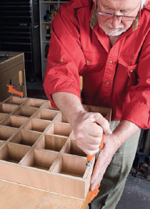
There have been some references on the forums to torsion boxes. What are they and when do you use them?
Ian Kirby: A torsion box has three parts to it:
1. The skin
2. The core
3. The glue
The skin is usually plywood or MDF. The core that industry uses is a honeycomb of paper. The skin’s top and bottom are held to the core with PVA glue. A flush door is an example of a torsion box.
I use 5/16″ thick poplar for the skin of my torsion boxes. The width of the corestock is the thickness of the torsion box less the thickness of the skins. If you want a 3″ thick table top and you are using 1/4″ plywood skins, the core size is 5/16″ x 2 1/2″. The core stock is built in the form of a grid. The parts are put together dry using crown staples on the top and bottom edges of the core. With a 1/4″ skin, the grid is made so the parts are 4″ on center.
Once the skins are glued in place, the panel becomes very rigid ? its strength to weight ratio is off the charts! The way to understand what a torsion box is good for is to compare it to a frame and panel. With a frame and panel structure, you can make doors, wall paneling, chests, tables, headboards and furniture of all kinds.
The frame and panel is a ‘building brick’ of woodworking, and so is the torsion box. You can use it for shelves, tabletops, pedestal ends, seating, you name it. It’s as useful as a designer’s mind can imagine it.





